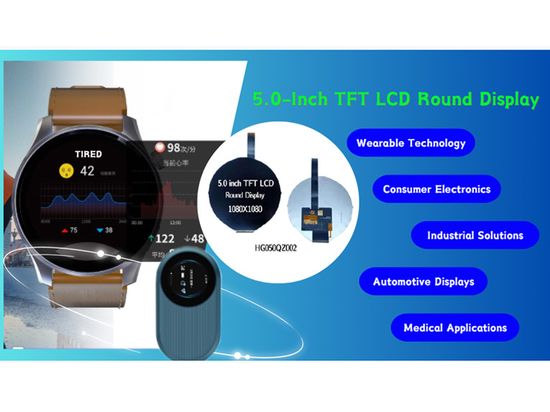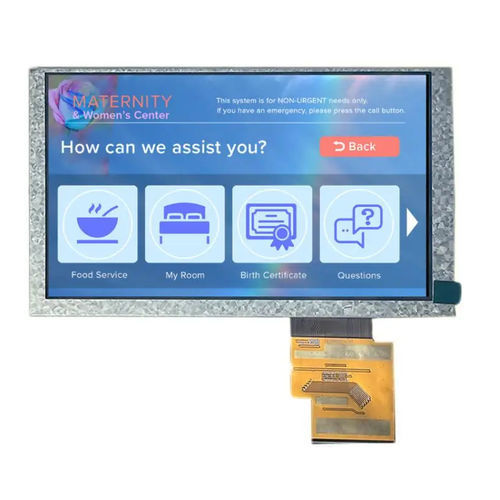
#Industry News
How does the LCD Display Screen Work?
In today’s digital era, TFT LCD screens have become ubiquitous, powering devices ranging from smartphones and laptops to televisions and digital signage.
In today’s digital era, TFT LCD screens have become ubiquitous, powering devices ranging from smartphones and laptops to televisions and digital signage. This blog aims to provide an in-depth understanding of how TFT LCD screens work, exploring their construction, operation, and the key components involved.
I. TFT LCD Screen Construction
TFT LCD screens consist of several layers that work together to produce vibrant and dynamic visuals. These layers include:
● Substrate Layers
Glass Substrates: TFT LCD screens typically use two glass substrates sandwiched together to form a display panel. These glass substrates provide mechanical support and serve as a foundation for other layers.
Transparent Electrodes: Thin layers of transparent conductive material, such as indium tin oxide (ITO), are applied to the glass substrates. These electrodes enable the application of electric fields to control the liquid crystals.
● Active Matrix Structure
Thin-Film Transistors (TFTs): On one of the glass substrates, an array of thin-film transistors is fabricated using semiconductor materials like amorphous silicon (a-Si) or low-temperature polysilicon (LTPS). Each TFT acts as a switch, controlling the voltage applied to individual pixels.
Color Filter Array: A color filter layer is placed on top of the TFT array. It consists of red, green, and blue color filters arranged in a precise pattern, corresponding to the subpixels of each pixel.
Liquid Crystal Layer: Between the glass substrates, a layer of liquid crystals is filled. Liquid crystals are organic compounds that can change their orientation in response to electric fields. They act as a light modulation medium, controlling the amount of light passing through the display.
II. Operation of a TFT LCD Screen
● Backlighting
Cold Cathode Fluorescent Lamp (CCFL): Traditional TFT LCD screens use CCFL tubes as a backlight source. These tubes emit white light, which passes through the layers to create the initial illumination.
Light-Emitting Diodes (LED): With advancements in technology, LED backlighting has become the norm. LEDs offer higher energy efficiency, better color reproduction, and thinner form factors.
● Pixel Control
TFT Transistors and Voltage Control: Each pixel on the display is associated with a TFT transistor. By applying voltage to the transistor, the liquid crystal molecules in the corresponding pixel can be aligned or twisted, controlling the passage of light.
Addressing Individual Pixels: The TFT transistors are arranged in a matrix pattern. By selectively activating the transistors, electrical signals can be sent to specific pixels, allowing for precise control of each pixel’s behavior.
● Color Reproduction
RGB Color Model: TFT LCD screens employ the RGB color model, where each pixel is composed of red, green, and blue subpixels. By varying the intensity of each subpixel, a wide range of colors can be produced.
Subpixel Arrangement: The sub pixels are arranged in a specific pattern, typically RGB, horizontally or vertically, to achieve the desired color reproduction and pixel density.
III. Working Principle of TFT Transistors
● Thin-Film Transistor (TFT)
Amorphous Silicon (a-Si) TFTs: These TFTs are commonly used in TFT LCD screens. They are fabricated by depositing a layer of amorphous silicon on the glass substrate. While a-Si TFTs are cost-effective, they have slower response times and lower electron mobility.
Low-Temperature Polysilicon (LTPS) TFTs: LTPS TFTs offer higher electron mobility and faster response times compared to a-Si TFTs. They are made using polysilicon deposited at low temperatures, resulting in a more crystalline structure.
● Active and Passive Matrix
Active Matrix TFT LCDs: Active matrix displays use an individual transistor for each pixel. This ensures precise control of each pixel’s behavior and enables faster refresh rates and better image quality.
Passive Matrix TFT LCDs: Passive matrix displays use a matrix of electrodes to address rows and columns of pixels. However, they suffer from slower response times, limited resolution, and lower contrast ratios.
Related: PMOLED vs. AMOLED: What is the difference?
IV. Liquid Crystal Layer and Pixel Operation
● Liquid Crystal Alignment
Nematic Liquid Crystals: The most common type of liquid crystal used in TFT LCD screens is the nematic liquid crystal. Nematic liquid crystals align parallel to the applied electric field when a voltage is present.
Alignment Layers: Alignment layers are applied to the inner surfaces of the glass substrates to control the orientation of the liquid crystal molecules. These layers ensure uniform alignment and prevent undesirable effects such as image ghosting or color shifts.
● Pixel States
Twisted Nematic (TN): In a TN display, the liquid crystal molecules twist between two glass substrates to control the polarization of light passing through them. By varying the voltage applied to the TFT transistor, the twisting angle of the liquid crystal molecules can be adjusted, allowing control over the passage of light.
In-Plane Switching (IPS): IPS displays use a different liquid crystal alignment technique. In this case, the liquid crystal molecules align horizontally between the glass substrates when no voltage is applied. Applying a voltage causes the molecules to align vertically, thus modulating the light transmission.
Vertical Alignment (VA): VA displays have liquid crystal molecules that align perpendicularly to the glass substrates when no voltage is present. The application of a voltage causes the molecules to align horizontally, thus controlling the light passage.
Related: TN vs. IPS vs. VA: What’s the Best LCD Display Technology?
V. Driving Signals and Addressing Pixels
● Scanning Methods
Line-by-Line Scanning: In this method, the display is scanned sequentially, line by line, from the top to the bottom. Each row of pixels is activated in sequence to create a complete image.
Time Division Multiplexing (TDM): TDM involves dividing the display into multiple time slots. Pixels are addressed in a cyclical manner, rapidly switching between different rows or columns during each time slot.
● Voltage Control
Analog Voltage Control: In earlier TFT LCD screens, analog voltage control was used to adjust the voltage applied to each pixel. This method allowed for smooth gradations of brightness and color.
Pulse Width Modulation (PWM): PWM is a commonly used technique where the voltage applied to each pixel is rapidly switched on and off. By adjusting the duty cycle, the average voltage across the pixel can be controlled, resulting in varying brightness levels.
VI. Conclusion
TFT LCD screens have revolutionized the display technology, bringing vibrant visuals and immersive experiences to various devices we use daily. By understanding the construction, operation, and key components of TFT LCD screens, we gain insight into their remarkable capabilities and appreciate the engineering marvel behind these displays. As technology continues to advance, TFT LCD screens will undoubtedly play a pivotal role in shaping the future of visual communication.





